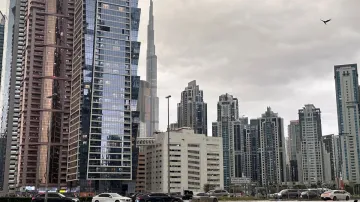Dubai witnesses severe flooding after getting 2 years' worth of rain in just 24 hours I KNOW WHY
The Dubai weather department recorded the highest rainfall in the Khatm Al Shakla area in Al Ain, reaching 254 mm in less than 24 hours. The National Centre of Meteorology said that the Shuwaib station had recorded 287.6 mm on March 9, 2016.
Dubai floods: The United Arab Emirates (UAE), which had the record of the lowest rainfall due to its demographic outfit, has witnessed torrential rainfall in recent years. According to the Dubai Meteorological Department, the city recorded severe flooding on Tuesday after two years' worth of rain fell in just 24 hours. In a report released by the Dubai weatherman on Tuesday, it claimed the region recorded 6.26 inches of rain within 24 hours, starting from Monday 10 pm.
Usually, the desert region receives 3.12 inches of rainfall annually. It means the city received rainfall worth two years within a day. The department, citing its record asserted Dubai typically receives 0.13 inches of rain during the month of April. However, this time, the West Asian nation witnessed its heaviest rainfall in 75 years from late Monday through Tuesday night. Notably, Dubai started recording precipitation data in 1949.
VIDEO: Extreme rain causes flood in Dubai
Panic situation
In the past few days, Dubai has been witnessing a deadly situation at shopping malls, roads, metro stations, airports and residential areas. People all around the city were seen taking desperate actions to reach home. At the airports, several airlines have cancelled their flight operations, citing bad weather situations. As of writing the article, the dynasty government did not reveal any data on deaths or injuries but local media reports claimed the flash flood killed a person on Wednesday.
READ: Dubai floods: Flydubai suspends all flights including for India due to bad weather
A similar episode was witnessed at metro stations as several lines were closed temporarily as the electric connections were affected badly. Roads have become oceans, as videos which went viral on social media platforms show cars and other vehicles drowned in the water caused by torrential rains. Schools were ordered to shut down, whereas corporate companies asked their employees to work remotely.
Why is Dubai witnessing flash floods in April?
Although a recent report released by the United Nations accused multiple reasons, climate change still has dominance over other factors. Ahead of the climate conference which was held on November 30 last year, the UN Climate Change released a progress report on climate action. The report underscored that progress on global climate action is moving too slowly to keep up with the effects of global warming.
"The Global Stocktake report released by UN Climate Change this year clearly shows where progress is too slow. But it also lays out the vast array of tools and solutions put forward by countries. Billions of people expect to see their governments pick up this toolbox and put it to work," Simon Stiell, Executive-Secretary of UN Climate Change said.
Stiell stressed that climate change has increased the intensity, frequency and variability of extreme weather events in several countries including, the UAE.
Cloud seeding
The region has been cursed due to its demographic orientation. In summer, the temperature goes up to 50 degrees Celsius, whereas in winter, the mercury dips to 16. More or less, the region is dry, hot and humid. The city depends on groundwater for daily needs. In order to cope with the situation, the UAE has been utilising innovative solutions for the past few decades.
Since 1982, the UAE has been using cloud seeding technology, which is also known as artificial rain. However, later, the UAE's Rain Enhancement Program (UAEREP), managed by the Emirates' National Centre of Meteorology (NCM), took the research to new heights in order to beat the side effects of artificial rains.
The scientists utilised natural salts to force the clouds to precipitate. Unlike other nations, it avoided using silver iodide, a crystal-like material in order to circumvent the ill effects on the environment. Despite taking the utmost care in the cloud seeding process, science raises concern over the side effects.
Lack of proper drainage system
Although the city has marvellous infrastructure that attracts millions of tourists around the globe, it lacks a proper drainage system. The main reason behind the insufficiency lies in the history. The city received very little rainfall, which resulted in the administration overlooking the situation. This prompts waterlogging on roads and other high-profile regions.
Also Read: Dubai turns into ocean as massive floods disrupt flight, school and train services I VIDEO
